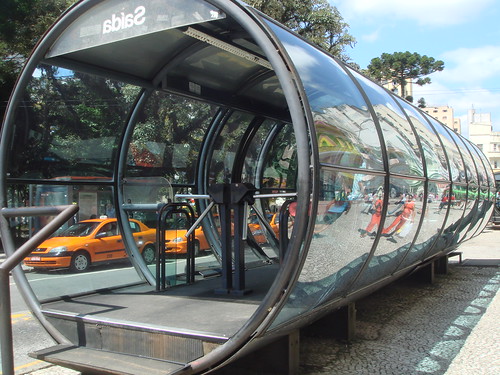Curitiba, Brazil. Population: 1.6 million

Many of you may be familiar with Bogota, a city now famous for its rapid bus transit system. But in fact, Curitiba was the inspiration for Bogota's bus system.
Back in the 1960s, Curitiba's planners decided to develop a city that would service the bulk of the city's transport needs. So instead of building the city for cars, which would only service the minority of the population that could afford a car, they decided to design the city for efficient bus transit. Thus, the city was designed to promote equity. Buses were chosen for a simple reason: they're cheaper. (Los Angeles, take note.) The designers of Curitiba recognized that they could build an efficient, well-designed bus system at a fraction of the price of a subway system.
The bus system was designed and refined over the years so that there are now three different types of buses. The rapid transit buses, the inter-district buses which run the long haul trips, and the local feeder buses that feed into the rapid transit and inter-district buses. Everyone pays a single fare which includes transfers. This means that the poorer people who often live on the edges of the city are not forced to pay more than the richer people who might be able to afford to live within the city center.
Now, you may think that the bus system alone is enough to make Curitiba awesome. And it is. By the 1990s, two-thirds of Curitiba's population used public transit!
But public transit isn't the only area that Curitiba excels in. It's also won two awards from the United Nations Environment Programme for waste management. Curitiba has come up with an innovative solution for dealing with sanitation issues in the favelas, or squatter settlements. The government instituted a program that allowed residents of favelas to turn in their trash in exchange for bus tickets or food. This greatly improves the quality of life for the urban poor. And the program doesn't cost anymore than it would cost the government to hire out a private contractor to collect the trash.
Curitiba also boasts an amazing rate of recycling: approximately 2/3 of the city's waste is recycled! The money that the government makes from the recycling gets funnelled into social programs for low-income sectors, including environmental education for children. Children learn how to recycle and grow vegetables. The teenagers can use their gardening skills to earn money for their neighborhood associations.
Think this sounds great, but what about the parks? Well, Curitiba has loads of those too! And not only are the parks there for recreation and green space, but they also serve a vital need. Many of the parks contain artificial lakes, and these lakes serve as flood control for the city.
Now, certainly, every major city has its problems, and Curitiba is no exception. It's not a perfect city. But it is an example of innovative and inexpensive urban design. It's an example of a city that has learned to harmonize environmental sustainability with people's welfare. In short, it's an example well worth emulating.
Picture courtesy of flickr user xander76



5 comments:
New Delhi (India) tried to implement the rapid bus transit system for the forthcoming Commonwealth Games but the scheme failed miserably resulting in traffic jams.
Public transport has now become an even more important part of city planning since it is not only cost efficient, it is clean and helps reduce dependence on fossil fuels.
Yesterday I read an article by San Fransisco's Mayor Gavin Newsom claiming that his city now recycles 75% of all waste generated. Maybe other cities would draw inspiration from Curitiba and San Fransisco.
All the best for your exams!!
Wow! This is awesome. Thanks for sharing!
Smart idea, combining blog writing with studying. ;) I have thought about trying to do that before. What a cool city! I don't quite understand how the bus works but it sounds awesome. See, there are ways to get around everything once people get interested in change.
This is really cool - more! more! I want to learn about the stuff you are studying. Totally a win win.
Actually I hear for the first time that a city was planned for bus traffic from the very beginning. It is very interesting!
Post a Comment